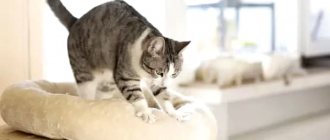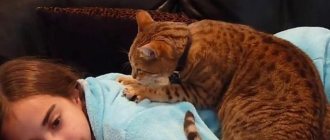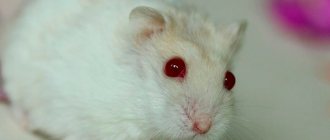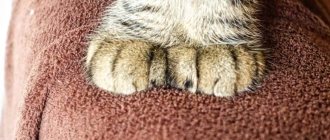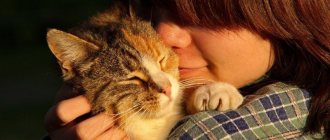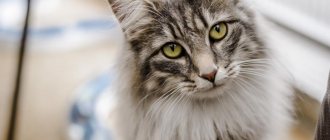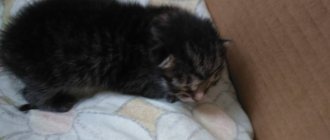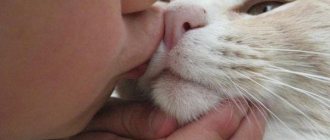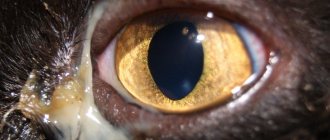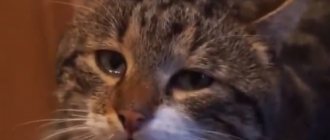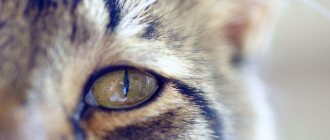Almost all people have noticed that the cat, having jumped on the owner, begins to walk around him, as if dancing, marking time in one place. He always starts out carefully, then speeds up, moves more sharply, then seems to forget himself and, at this time, can release his claws. Many people wonder why a cat tramples you with its paws and what this ritual means, does it have any meaning for the pet or for the owner?
Reasons from the point of view of scientists
Of course, no one can accurately answer the question of why a cat tramples you with its paws. People have only some assumptions why she does this:
- Childhood memories. According to natural data, in order for a kitten to receive mother's milk, it is forced to put pressure on the mammary glands. This is how stimulation and release of nutrition for the baby occurs. Childhood memories settle in the kitten’s mind, and already in adulthood, in moments of calm, out of inertia, he performs similar actions. After all, he experiences the same warm feelings for his owner, and the cat is rewarded with such signs of attention only by his loved ones, and not by everyone living in the same house with him.
- The next assumption why cats trample is a natural instinct. In ancient times, when cats were wild animals, they made their own den. To do this, they trampled down the vegetation, thereby making it soft, and at this time they walked in a circle. Now they do not need such movements, but the instinct is passed on from generation to generation.
- Another version is a sense of ownership. Zoologists claim that cats have special glands in their paw pads that secrete sweat, with such a subtle odor that only cats can smell it. In a similar way, the pet marks the owner from other cats, thereby saying that he is busy.
- Another idea why cats trample is to check the territory. That is, with such movements they check whether everything is in order for comfort. It is with their paws that pets check for cold and sharp objects.
- Another version of why cats trample, which people really adore, is that a person and his pet understand each other so well that they feel the emotional mood, whether there is any disorder or even depression. If cats trample us with their paws, then in this way they want to improve the internal state of the owner. During these actions, the pet releases a hormone of joy: endorphin, which has a calming effect on the owner and pet.
- Another assumption is that the cat at this time feels a hormonal surge and the need for a cat. Neutered cats also suffer from this; their needs for the opposite sex do not go away immediately, but after some time.
Unconfirmed assumptions
The remaining reasons are considered unconfirmed assumptions. They also explain why cats knead their paws, but they have some nuances that do not allow them to be classified as the main ones.
Marking territory
The sweat glands of mustachioed pets are located directly on the pads of their paws, so in the heat they leave wet marks on the tiles. In addition to cooling the body, the enzymes released help repel uninvited guests. This feature is actively used for marking territories. Most often, females resort to it, since males spray an odorous secretion when urinating.
When marking territory, cats practically do not trample, but simply scratch with their paws. Unlike regular kneading, such touches increase the coverage area and increase the security of the territory.
Hunting
If we consider all possible reasons, then it makes sense to note the hunting instinct. He explains why cats crush the surface with their hind paws before attacking. In this case, this movement helps to ensure safety: the absence of noisy leaves and too soft soil under the paws in which you can get stuck.
Despite the fact that in most domestic animals the role of prey is played by a toy mouse, and the role of soil is a stable laminate, the habit inherited from wild ancestors is still preserved.
Host treatment
Cats love warmth, so they can sense inflammation a mile away and prefer to “heal” their owners. In fact, they simply settle down on the warmest and softest place possible, massaging it before curling up into a ball.
Vibrations during purring really have a beneficial effect on health, but the removal of negative energy and the miraculous treatment of diseases with their help is just a myth. If after a cat massage your mood and well-being improve, then it is important to understand that “after” does not mean “as a result.” Most often, these problems are solved by banal rest and taking medications.
Stress relief
The last unconfirmed hypothesis explaining why cats paw is associated with endorphin, the pleasure hormone. Cat pads are equipped with many receptors responsible for the sense of touch. Trampling soft and pleasant to the touch surfaces stimulates the production of endorphins, reducing stress levels.
Because of this, many pets wrinkle the blanket after returning from the veterinarian or a recent punishment for stealing sausages. At such moments it is better not to touch them, since before the steam is completely released they can take out their dissatisfaction on your hand.
How to behave when cats trample on the owner's body
Many do not understand how to behave if cats trample on a person with their paws, when they jump on us with a tender face, position themselves like a master and begin to trample, as if kneading dough. Moreover, cats can calmly release their claws at this time, but their reaction shows that these actions were not part of their plans.
Sometimes we have an ambiguous reaction to this, especially if sharp claws are pierced into a soft part of the body. There is no need to drive your pet away; you must remember that in this way he shows trust and love. If the cat is driven away at this time, it will suffer emotional stress and may even harbor a grudge.
When cats, trampling with their paws, put their claws into the owner's skin, then for safety reasons you can try to trim their nails. It is better to carry out this procedure by a specialist so as not to injure the animal. You can also use a special machine for this, which trims the claws a little, literally by 1-2 mm. It is better to carry out this procedure together so as not to injure the animal.
When the owner knows that his pet is prone to actions that cause him discomfort, then some tricks can be used to calm the animal's ardor. When a cat begins to trample the owner with its front paws, you need to hold them back a little and try to distract the pet with affection or a toy. Another maneuver during unwanted behavior is to gently pull the cat down. This way he will calm down and go to sleep. An option to distract from unwanted cat actions is to change the timbre of the voice; when the owner changes the intonation slightly, the pet becomes alert and changes its behavior.
Genetic memory
Representatives of the cat guild are often called sybarites - they really love comfortable conditions.
In the house, the cat chooses its own bed, settling in the most comfortable, clean and warm place.
A fluffy beauty curled up into a ball is the personification of bliss and comfort.
Some researchers explain the desire of cats to create comfortable conditions even in the wild for their habit of trampling a person, bed or toys with their paws.
It is believed that a wild cat, in its desire to make its sleeping place as comfortable as possible, tramples down leaves and branches so that it can sleep sweetly and comfortably.
Cats of all breeds love to trample their paws, from baby munchkins , graceful bengals and ending with giant pets like ragdolls or caracals .
Domestic cats also sometimes like to make a nest for themselves and sleep in the grass
Popular opinion
Traditional healers, when asked why a cat tramples on its owner, give a different interpretation. It is likely that the mustachioed magician finds a place that has less vital energy. By performing a massage with their front paws, they seem to be treating us, bringing energy balance. When a cat seems to enter into a role, trampling on a person’s body, it seems to be in a misunderstanding of what is happening at this moment. It is at this time that the exchange of bioenergy occurs between the animal and its owner.
Eastern sages, studying this phenomenon, claim that cat energy is closest to human energy. This phenomenon does not occur in any other animal. During bioenergetic contact, healing occurs. Eastern medicine claims that 15 minutes of cat massage can relieve depression, and it’s not at all scary when a kitten digs its claws into the skin, thereby stimulating the active zones of the body. They act like needles during acupuncture.
Experts believe that there is no difference whether a purebred pet or a barn cat does the massage. The main thing is that the pet warms up to the owner, so that he likes the person. Cats have an amazing ability to lie down and massage the area where there is a problem.
Emotional factor
Cats, like all living things, can experience stress.
It happens that a pet begins to trample the sofa with such frenzy that one cannot suspect echoes of a carefree childhood in this action.
And all because the owners made a lot of noise, did not feed them on time, drove them out of their favorite place on the chair, took away their favorite toy, etc.
And the cat begins to furiously torment the sofa, thus throwing out its dissatisfaction.
After such a surge of emotions, the animal, as a rule, calms down and can even go to make peace with its owner.
Complete harmony between four-legged friend and owner
Are there cats that don't have this habit?
Artificially raised kittens that have never fed their mother's milk are deprived of this habit. For this reason, they did not develop a conditioned reflex. Sometimes, when a mother cat has a large amount of milk and few kittens, her babies also do not have the need to trample a person, because they receive food in abundance. They had no need to obtain additional food.
There are many versions of this question, but the only ones who can reliably answer it are our tailed pets. But they don’t allow people into their secret world yet.
What does claw extension mean?
While performing the “milk step,” the animal’s body relaxes and the function of retracting and extending its claws is involuntarily triggered.
While trampling, a cat may release its claws, involuntarily injuring a person. But you shouldn’t be offended by this impulse of your pet. This is another manifestation of cat love.
The movement of the paws promotes the release of secretion from the back of the paws, which is rubbed into the fabric and other surfaces. Therefore, your pet may scratch your arms or legs (mark it as property).
Mechanism
How does a cat’s “purr” work, and what is it anyway? Have you ever wondered how kittens create this sound and why people like it so much? There are several theories about the origin of purring.
Vocal cords
Taking a closer look at your animal, you will probably think that the tummy makes a continuous sound. But that's not true. There is an opinion that a cat purrs precisely through the vocal cords, but the process “starts” in the cerebral cortex. The muscles of the larynx, at the behest of the animal, begin to vibrate sweetly and emit a soothing and pleasing purr (or, conversely, the battle cry of meowing).
Diaphragm
Scientists also believe that purring sounds come from the diaphragm or, more simply, from the lungs. That is, they are provoked by vibrations in the cat’s lungs. Experts think this because the cat purrs in time with its breathing. This set the stage for thought.
Vascular theory
The vascular theory states that the “clattering” occurs due to the pressure created in the cat's body by the blood circulation. Under the influence of certain emotions, the pressure difference causes the chest to vibrate and the cat makes the very sounds that we hear and call “purring.”
These are mysterious animals! And yet, scientists have solved the mystery! The vibration spreading throughout the body comes from the hyoid bones. They are located between the base of the skull and the base of the tongue of animals.
Reference! It is because of the contraction of the muscles of the vocal cords that vibration occurs, accompanied by pleasant purring sounds.
Unrealized sexual instinct
Why do some pets climb onto the bed, stomp on it, arching their backs and meowing loudly? This behavior is probably associated with the beginning of the mating season. You can recognize it by the fact that the cat tramples the sofa or bed not with its front paws, as usual, but with its hind paws, and the cat grabs the bedspread with its teeth.
This usually does not last long; after 10–14 days or with the onset of pregnancy, the fingering of the paws and expressive meowing stops. The male can be caught doing this activity at any time.
[custom_ads_shortcode3]
Selecting a territory
It is believed that the sweat glands on the paw pads of cats are involved in the process of identifying territory. The chemical composition of secretions in all living organisms, including humans, is unique to each individual. Animals can indeed communicate in this way what belongs to them. This is an instinctive process and it occurs spontaneously: a signal is recorded in the pet’s brain about the need to mark the territory. The favorite is reminded of this by the most ancient mental attitudes.
If a cat tramples a person with its paws, this means that the animal appreciates him and wants the owner to always be with him.
Why does a pet move its paws and purr on the bed or sofa?
These animals do not always choose their owners as objects for pawing. You can often notice that a cat climbs onto a bed or sofa and crumples a blanket or bedspread with its paws. Why is she doing this?
There may be several reasons why cats stomp on the bed. This is probably how pets prepare a place to rest, relieve emotional stress, realize sexual instinct, or leave marks.
[custom_ads_shortcode3]
Thanks for the compliment
As a rule, the cat chooses one person as the object of “trampling”. You won’t envy this “lucky one”... The one whom the pet recognizes as its mother now becomes a nanny for the purring family member. Feed on time, clean the tray, take to the veterinarian, play - all these worries will fall on your shoulders.
And do not console yourself with the thought that you took on these responsibilities voluntarily. This is your pet, having given you a compliment, “appointed” you as responsible for his happy existence.
On the other hand, this is even for the better. You will be able to receive sessions of relaxation and confidential communication with your cat more often than others.
People's opinion
Many people think that by purring and trampling its owner’s body with its paws, the animal performs some kind of therapeutic manipulation.
Read also: 1.Material and spiritual existence
There is an opinion that cats are able to stabilize the energy balance in the human body. If a cat starts doing its “massage”, it automatically exchanges biological energy, removing bad energy and giving the person its own positive energy. It has been noticed that cats most often lay down on problem areas of the body. However, this effect is not inherent in all pets, but only in those that have a powerful emotional connection with the owner.
Cats have long been credited with various mystical powers, including healing humans. At the same time, the effectiveness of feline therapy is confirmed by the results of numerous studies on this topic. There is even official information that confirms that cats can sense a pre-infarction state and find areas of localization of malignant formations.
Read also: Crystal Owl and its history
As for therapy with cats, the famous cardiologist A.I. Lavrushin states that the animal, by trampling on the body of its owner, tries to normalize blood circulation.
Eastern sages are sure that fingering a cat’s paws is precisely a massage procedure: thus, animals relieve a person’s feeling of fatigue and tension. If claws are also used, such treatment is comparable in effectiveness to full-fledged acupuncture.
Read also: The role of the Russian Federation in the CIS
